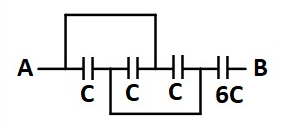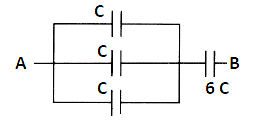
The equivalent capacitance between A and B is

(A)C
(B) 3C
(C) 9C
(D) 2C

Answer
544.5k+ views
Hint: For finding equivalent capacitance of the network, check the connections made i.e. capacitances which are in series combination and in parallel combination. Then apply the formula for net capacitance which is for series, the formula for net capacitance is given as
$\dfrac{{\text{1}}}{{{{\text{C}}_{{\text{net}}}}}}{\text{ = }}\dfrac{{\text{1}}}{{{{\text{C}}_{\text{1}}}}}{\text{ + }}\dfrac{{\text{1}}}{{{{\text{C}}_{\text{2}}}}}{\text{ + }}\dfrac{{\text{1}}}{{{{\text{C}}_{\text{3}}}}}{\text{ + }}....{\text{ + }}\dfrac{{\text{1}}}{{{{\text{C}}_{\text{n}}}}}$
And for parallel combination, the formula for net capacitance is given as
${{\text{C}}_{{\text{net}}}}{\text{ = }}{{\text{C}}_{\text{1}}}{\text{ + }}{{\text{C}}_{\text{2}}}{\text{ + }}{{\text{C}}_{\text{3}}}{\text{ + }}....{\text{ + }}{{\text{C}}_{\text{n}}}$
Complete step by step solution:
First three capacitors having capacitance C each are arranged in parallel combination and last capacitor having capacitance 6 C is arranged in series with them.
Equivalent diagram is shown below

Now, finding capacitance for first 3 capacitors having capacitance C each arranged in parallel combination. The formula for parallel combination, the formula for net capacitance is given as
${{\text{C}}_{{\text{net}}}}{\text{ = }}{{\text{C}}_{\text{1}}}{\text{ + }}{{\text{C}}_{\text{2}}}{\text{ + }}{{\text{C}}_{\text{3}}}{\text{ + }}....{\text{ + }}{{\text{C}}_{\text{n}}}$
Here, only three capacitances are there so formula can be written as
${{\text{C}}_{{\text{net}}}}{\text{ = }}{{\text{C}}_{\text{1}}}{\text{ + }}{{\text{C}}_{\text{2}}}{\text{ + }}{{\text{C}}_{\text{3}}}$
According to the question, ${{\text{C}}_{\text{1}}}{\text{ = }}{{\text{C}}_{\text{2}}}{\text{ = }}{{\text{C}}_{\text{3}}}{\text{ = C}}$
Now substituting the value of C1, C2 and C3 in the above formula, we get
$
{{\text{C}}_{{\text{net}}}}{\text{ = C + C + C}} \\
\therefore {{\text{C}}_{{\text{net}}}}{\text{ = 3C}} \\
$
Now, capacitor having capacitance is arranged in series combination with${{\text{C}}_{{\text{net}}}}$.
For series combination, the formula for net capacitance is given as
$\dfrac{{\text{1}}}{{{\text{C}}{{\text{'}}_{{\text{net}}}}}}{\text{ = }}\dfrac{{\text{1}}}{{{{\text{C}}_{\text{1}}}}}{\text{ + }}\dfrac{{\text{1}}}{{{{\text{C}}_{\text{2}}}}}{\text{ + }}\dfrac{{\text{1}}}{{{{\text{C}}_{\text{3}}}}}{\text{ + }}....{\text{ + }}\dfrac{{\text{1}}}{{{{\text{C}}_{\text{n}}}}}$
Here, only two capacitances are there so formula can be written as
$\dfrac{{\text{1}}}{{{{\text{C}}_{{\text{net}}}}}}{\text{ = }}\dfrac{{\text{1}}}{{{{\text{C}}_{\text{1}}}}}{\text{ + }}\dfrac{{\text{1}}}{{{{\text{C}}_{\text{2}}}}}$
According to the question, $\dfrac{{\text{1}}}{{{\text{C}}{{\text{'}}_{{\text{net}}}}}}{\text{ = }}\dfrac{{\text{1}}}{{{{\text{C}}_{{\text{net}}}}}}{\text{ + }}\dfrac{{\text{1}}}{{{\text{6C}}}}$
Substituting the value of ${{\text{C}}_{{\text{net}}}}$in above formula, we get
$
\dfrac{{\text{1}}}{{{\text{C}}{{\text{'}}_{{\text{net}}}}}}{\text{ = }}\dfrac{{\text{1}}}{{{\text{3C}}}}{\text{ + }}\dfrac{{\text{1}}}{{{\text{6C}}}} \\
\Rightarrow \dfrac{{\text{1}}}{{{\text{C}}{{\text{'}}_{{\text{net}}}}}}{\text{ = }}\dfrac{{\text{3}}}{{{\text{6C}}}} \\
\Rightarrow \dfrac{{\text{1}}}{{{\text{C}}{{\text{'}}_{{\text{net}}}}}}{\text{ = }}\dfrac{1}{{{\text{2C}}}} \\
\therefore {\text{ C}}{{\text{'}}_{{\text{net}}}} = {\text{2C}} \\
$
So, the equivalent capacitance between A and B is 2C.
Therefore, option (D) is the correct choice.
Note:
Capacitance is the ability of a capacitor to store the charge.When charge is given to a conductor then its potential increases. SI unit of capacitance is farad (abbreviated F). CGS unit of capacitance is statfarad (abbreviated statF).
$\dfrac{{\text{1}}}{{{{\text{C}}_{{\text{net}}}}}}{\text{ = }}\dfrac{{\text{1}}}{{{{\text{C}}_{\text{1}}}}}{\text{ + }}\dfrac{{\text{1}}}{{{{\text{C}}_{\text{2}}}}}{\text{ + }}\dfrac{{\text{1}}}{{{{\text{C}}_{\text{3}}}}}{\text{ + }}....{\text{ + }}\dfrac{{\text{1}}}{{{{\text{C}}_{\text{n}}}}}$
And for parallel combination, the formula for net capacitance is given as
${{\text{C}}_{{\text{net}}}}{\text{ = }}{{\text{C}}_{\text{1}}}{\text{ + }}{{\text{C}}_{\text{2}}}{\text{ + }}{{\text{C}}_{\text{3}}}{\text{ + }}....{\text{ + }}{{\text{C}}_{\text{n}}}$
Complete step by step solution:
First three capacitors having capacitance C each are arranged in parallel combination and last capacitor having capacitance 6 C is arranged in series with them.
Equivalent diagram is shown below

Now, finding capacitance for first 3 capacitors having capacitance C each arranged in parallel combination. The formula for parallel combination, the formula for net capacitance is given as
${{\text{C}}_{{\text{net}}}}{\text{ = }}{{\text{C}}_{\text{1}}}{\text{ + }}{{\text{C}}_{\text{2}}}{\text{ + }}{{\text{C}}_{\text{3}}}{\text{ + }}....{\text{ + }}{{\text{C}}_{\text{n}}}$
Here, only three capacitances are there so formula can be written as
${{\text{C}}_{{\text{net}}}}{\text{ = }}{{\text{C}}_{\text{1}}}{\text{ + }}{{\text{C}}_{\text{2}}}{\text{ + }}{{\text{C}}_{\text{3}}}$
According to the question, ${{\text{C}}_{\text{1}}}{\text{ = }}{{\text{C}}_{\text{2}}}{\text{ = }}{{\text{C}}_{\text{3}}}{\text{ = C}}$
Now substituting the value of C1, C2 and C3 in the above formula, we get
$
{{\text{C}}_{{\text{net}}}}{\text{ = C + C + C}} \\
\therefore {{\text{C}}_{{\text{net}}}}{\text{ = 3C}} \\
$
Now, capacitor having capacitance is arranged in series combination with${{\text{C}}_{{\text{net}}}}$.
For series combination, the formula for net capacitance is given as
$\dfrac{{\text{1}}}{{{\text{C}}{{\text{'}}_{{\text{net}}}}}}{\text{ = }}\dfrac{{\text{1}}}{{{{\text{C}}_{\text{1}}}}}{\text{ + }}\dfrac{{\text{1}}}{{{{\text{C}}_{\text{2}}}}}{\text{ + }}\dfrac{{\text{1}}}{{{{\text{C}}_{\text{3}}}}}{\text{ + }}....{\text{ + }}\dfrac{{\text{1}}}{{{{\text{C}}_{\text{n}}}}}$
Here, only two capacitances are there so formula can be written as
$\dfrac{{\text{1}}}{{{{\text{C}}_{{\text{net}}}}}}{\text{ = }}\dfrac{{\text{1}}}{{{{\text{C}}_{\text{1}}}}}{\text{ + }}\dfrac{{\text{1}}}{{{{\text{C}}_{\text{2}}}}}$
According to the question, $\dfrac{{\text{1}}}{{{\text{C}}{{\text{'}}_{{\text{net}}}}}}{\text{ = }}\dfrac{{\text{1}}}{{{{\text{C}}_{{\text{net}}}}}}{\text{ + }}\dfrac{{\text{1}}}{{{\text{6C}}}}$
Substituting the value of ${{\text{C}}_{{\text{net}}}}$in above formula, we get
$
\dfrac{{\text{1}}}{{{\text{C}}{{\text{'}}_{{\text{net}}}}}}{\text{ = }}\dfrac{{\text{1}}}{{{\text{3C}}}}{\text{ + }}\dfrac{{\text{1}}}{{{\text{6C}}}} \\
\Rightarrow \dfrac{{\text{1}}}{{{\text{C}}{{\text{'}}_{{\text{net}}}}}}{\text{ = }}\dfrac{{\text{3}}}{{{\text{6C}}}} \\
\Rightarrow \dfrac{{\text{1}}}{{{\text{C}}{{\text{'}}_{{\text{net}}}}}}{\text{ = }}\dfrac{1}{{{\text{2C}}}} \\
\therefore {\text{ C}}{{\text{'}}_{{\text{net}}}} = {\text{2C}} \\
$
So, the equivalent capacitance between A and B is 2C.
Therefore, option (D) is the correct choice.
Note:
Capacitance is the ability of a capacitor to store the charge.When charge is given to a conductor then its potential increases. SI unit of capacitance is farad (abbreviated F). CGS unit of capacitance is statfarad (abbreviated statF).
Recently Updated Pages
Master Class 12 Business Studies: Engaging Questions & Answers for Success

Master Class 12 Economics: Engaging Questions & Answers for Success

Master Class 12 English: Engaging Questions & Answers for Success

Master Class 12 Maths: Engaging Questions & Answers for Success

Master Class 12 Social Science: Engaging Questions & Answers for Success

Master Class 12 Chemistry: Engaging Questions & Answers for Success

Trending doubts
What are the major means of transport Explain each class 12 social science CBSE

Which are the Top 10 Largest Countries of the World?

Draw a labelled sketch of the human eye class 12 physics CBSE

How much time does it take to bleed after eating p class 12 biology CBSE

Explain sex determination in humans with line diag class 12 biology CBSE

Differentiate between homogeneous and heterogeneous class 12 chemistry CBSE




